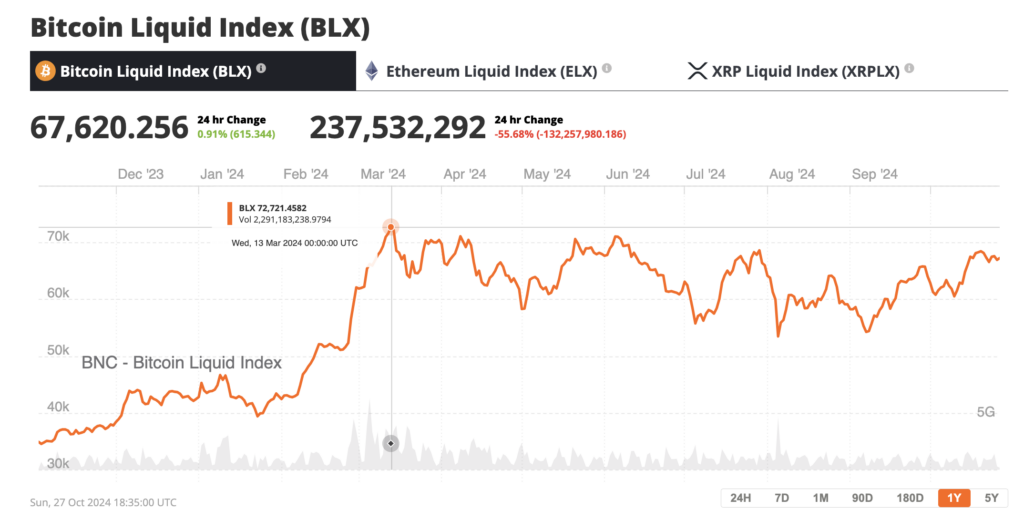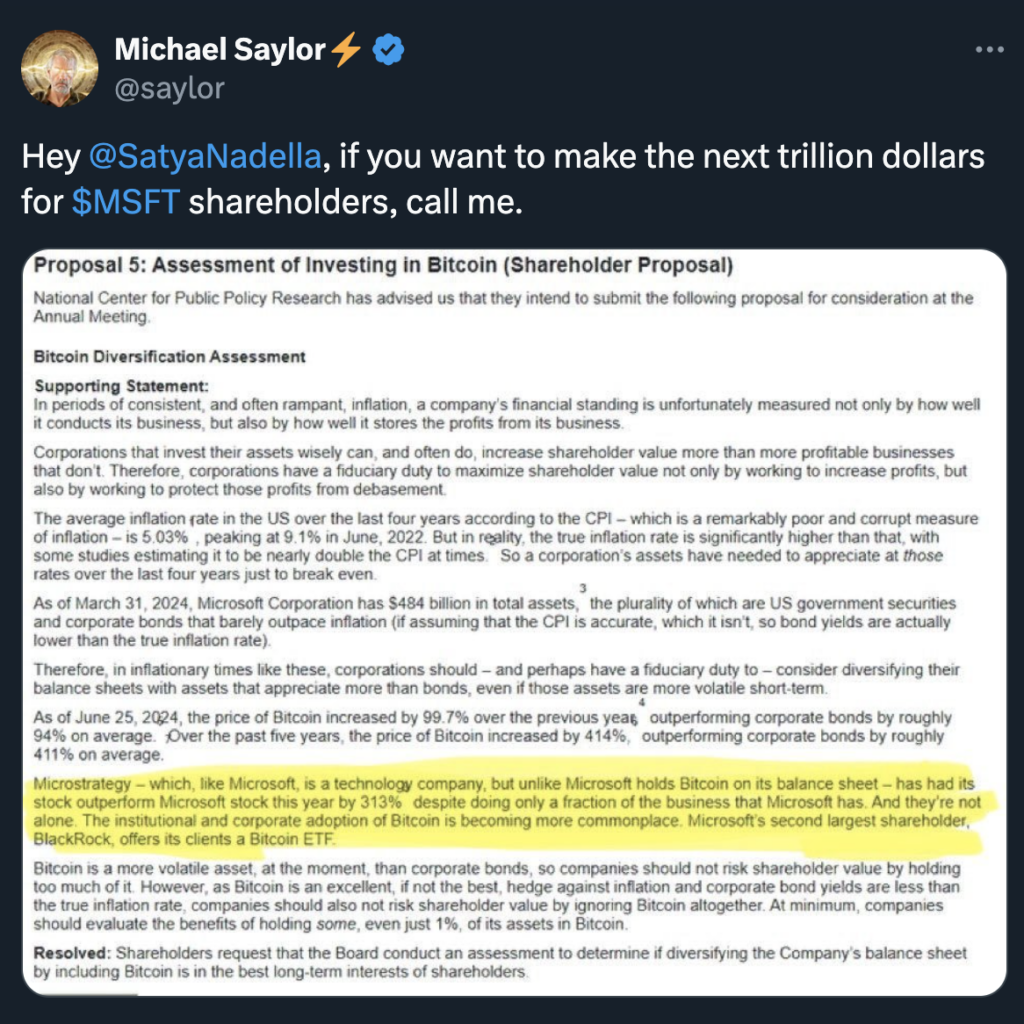Bitcoin is preparing to break free from its stagnant phase. After seven months of sideways trading, is Bitcoin finally on the verge of a major breakout?
Bernstein, a renowned investment firm, released a comprehensive report outlining reasons why Bitcoin could reach a new all-time high of $200,000 by the end of 2025. This projection is based on Bitcoin’s current price of approximately $68,000, suggesting a nearly 200% increase.

Bitcoin has been sideways since March: BNC Bitcoin Liquid Index
Bernstein analysts wrote that they believe Bitcoin will hit $200,000 by the end of 2025. And that’s being “conservative,” they said. “With accelerating institutional adoption, we expect Bitcoin to triple from here to attain a cycle-high price of $200,000 by 2025 end,” the report read.
The report sparked a frenzy among billionaire investors, who are rapidly increasing their Bitcoin holdings. Hedge fund managers and tech entrepreneurs lead this charge, believing Bitcoin is set for a substantial rally following the 2024 presidential election. This growing interest among the ultra-wealthy raises the question: could Bernstein’s optimistic forecast be accurate?
Michael Saylor, executive chairman of MicroStrategy, stands out as a prominent billionaire advocate for Bitcoin. At a Bitcoin conference in Nashville, Tennessee, this past summer, Saylor predicted Bitcoin could reach $13 million by 2045. His commitment to Bitcoin remains unwavering, with MicroStrategy now holding more than 1% of all Bitcoin in circulation. This aggressive investment strategy underscores his confidence in Bitcoin’s long-term potential.
Billionaire Investment in Bitcoin
Other tech magnates like Mark Cuban and Block’s CEO Jack Dorsey are increasingly investing in Bitcoin. Additionally, prominent Silicon Valley venture capitalists are venturing into this field, with some actively engaging in the 2024 presidential election campaigns. Jack Dorsey has boldly predicted Bitcoin’s price could soar to $1 million by 2030, indicating a strong belief in the cryptocurrency’s potential.
Matthew Sigel from VanEck summarized Bernstein’s 160-page “Black Book,” which argues for ongoing consolidation among Bitcoin miners. The report also notes that ten global asset managers now control approximately $60 billion in assets through regulated exchange-traded funds, a significant increase from $12 billion in September 2022.

Source: Farside Investors
Furthermore, the trend includes institutional investors. Billionaire hedge fund managers are now focusing on new Bitcoin exchange-traded funds (ETFs). Data from the Securities and Exchange Commission reveals that major funds, including Millennium Management led by Israel Englander, have made substantial investments in Bitcoin ETFs. Millennium Management initiated the year with a $2 billion investment. Over 600 investment firms maintain notable stakes in Bitcoin ETFs, underscoring broad institutional trust in the cryptocurrency.
Bernstein also highlights that this surge in billionaire investment stems from the anticipation of considerable short-term price gains. Commonly known in cryptocurrency circles as “Number Go Up,” this strategy involves purchasing Bitcoin in the hope of its value rising, independent of fundamental economic indicators. However, Bernstein notes that the reasons for billionaire investments in Bitcoin are not just speculative but are also driven by deeper strategic considerations.
Institutional Era Boosts Bitcoin Confidence
Bernstein highlights major catalysts propelling Bitcoin toward significant price appreciation. A transformative institutional era emerges as professional investors embrace cryptocurrency as a legitimate asset class. Spot Bitcoin ETFs create seamless market access, enabling Wall Street firms and wealthy investors to accumulate substantial holdings. Subsequently, massive capital inflows could propel valuations upward.
Increasing economic pressures drive Bitcoin adoption as a strategic hedge. Investors seek protection against hyperinflationary risks, mounting U.S. federal debt exceeding $35 trillion, and escalating Middle East conflicts. Moreover, JPMorgan Chase advocates a “debasement trade” strategy, recommending Bitcoin and gold positions to counter dollar weakness and global instability. Current projections indicate continued momentum through 2025, potentially elevating both assets’ values.
Microsoft’s annual shareholder meeting, scheduled for December 10th, has a hot topic on the agenda—a proposal advocating for the tech giant to diversify its holdings by investing in Bitcoin. Filed with the SEC, the proposal suggests that Bitcoin could enhance shareholder value and act as a hedge against inflation, outperforming Microsoft’s current investments in corporate bonds.
The proposal, titled “Assessment of Investing in Bitcoin,” argues that corporate bonds yield returns barely above inflation and suggests Bitcoin as a powerful alternative. According to the proposal, “In inflationary periods, corporations have a duty to consider assets with higher appreciation potential than bonds, even if they come with more short-term volatility.”
Michael Saylor, CEO of MicroStrategy, is ready to orange-pill Microsoft CEO Satya Nadella. In a tweet on X Saylor called on Nadella, saying, “Hey @SatyaNadella, if you want to make the next trillion dollars for $MSFT shareholders, call me.”

Source: X
Bernstein emphasizes Bitcoin’s evolved market role beyond speculative trading. Its unique position as both a growth opportunity and a protective asset attracts portfolio diversification. Market analysis suggests institutional capital deployment will boost Bitcoin through increased demand while reinforcing its position as an economic uncertainty shield.
Massive ETF Investments Signal Strong Future
The surge in Bitcoin ETF investments by hedge funds further underscores the positive sentiment surrounding Bitcoin. Millennium Management’s $2 billion investment in Bitcoin ETFs is a testament to the confidence that institutional investors have in the cryptocurrency’s future. With over 600 investment firms now holding significant positions in Bitcoin ETFs, the market is witnessing a substantial influx of capital that could propel Bitcoin to new heights.
This trend is not isolated to a few investors but is widespread across various sectors of the financial industry. The growing adoption of Bitcoin ETFs by institutional investors indicates a broader acceptance and integration of cryptocurrency into mainstream financial systems. As more firms recognize Bitcoin’s potential as a valuable asset, the demand is likely to increase, driving up its price in the process.
Bernstein’s report also highlights that this new institutional era is creating a positive feedback loop for Bitcoin. As more institutional money flows into the market, the increased demand can lead to higher prices, which in turn attracts even more institutional investors. This cycle can potentially result in significant price appreciation, supporting Bernstein’s prediction of a $200,000 Bitcoin by the end of 2025.




